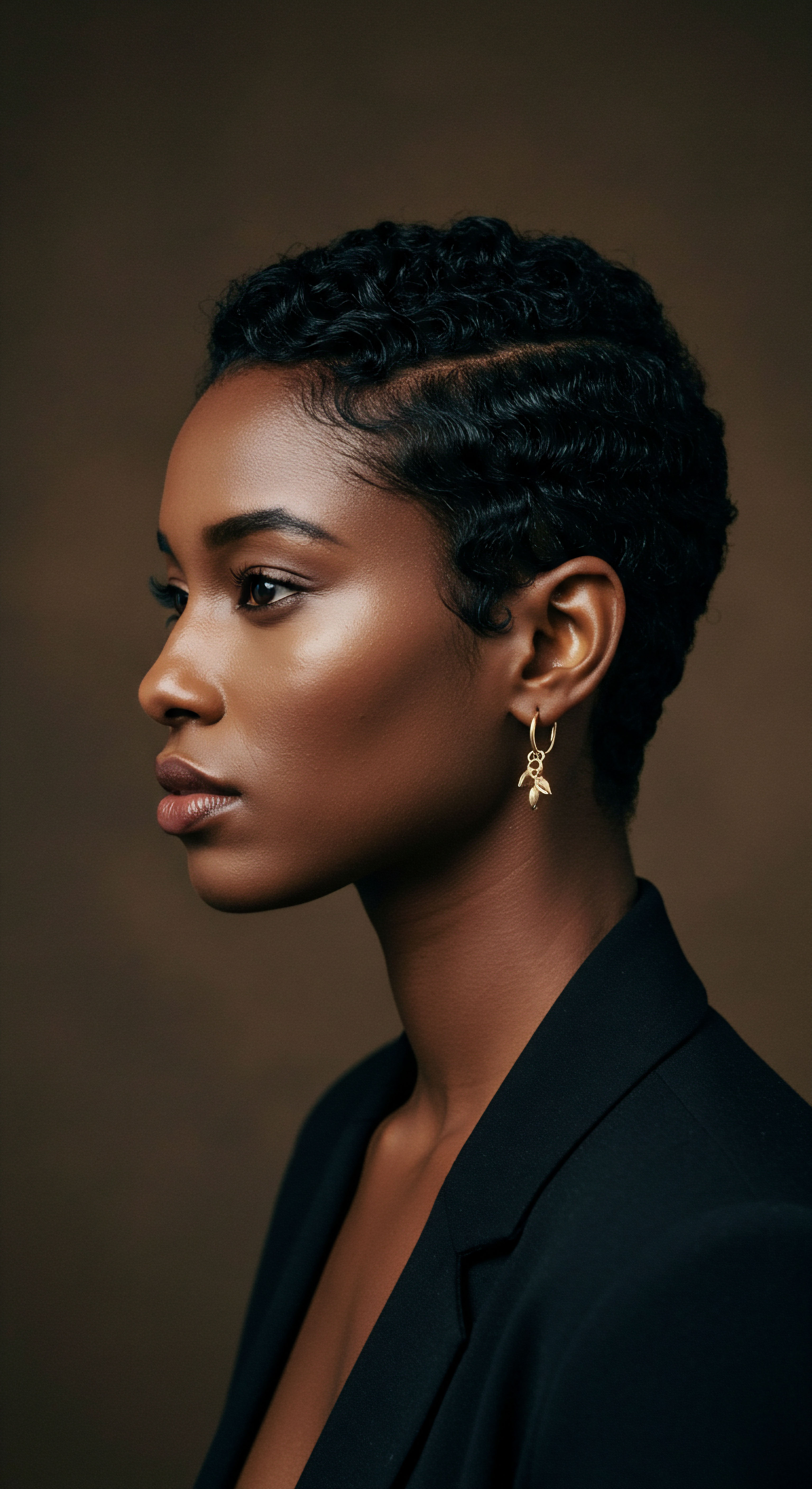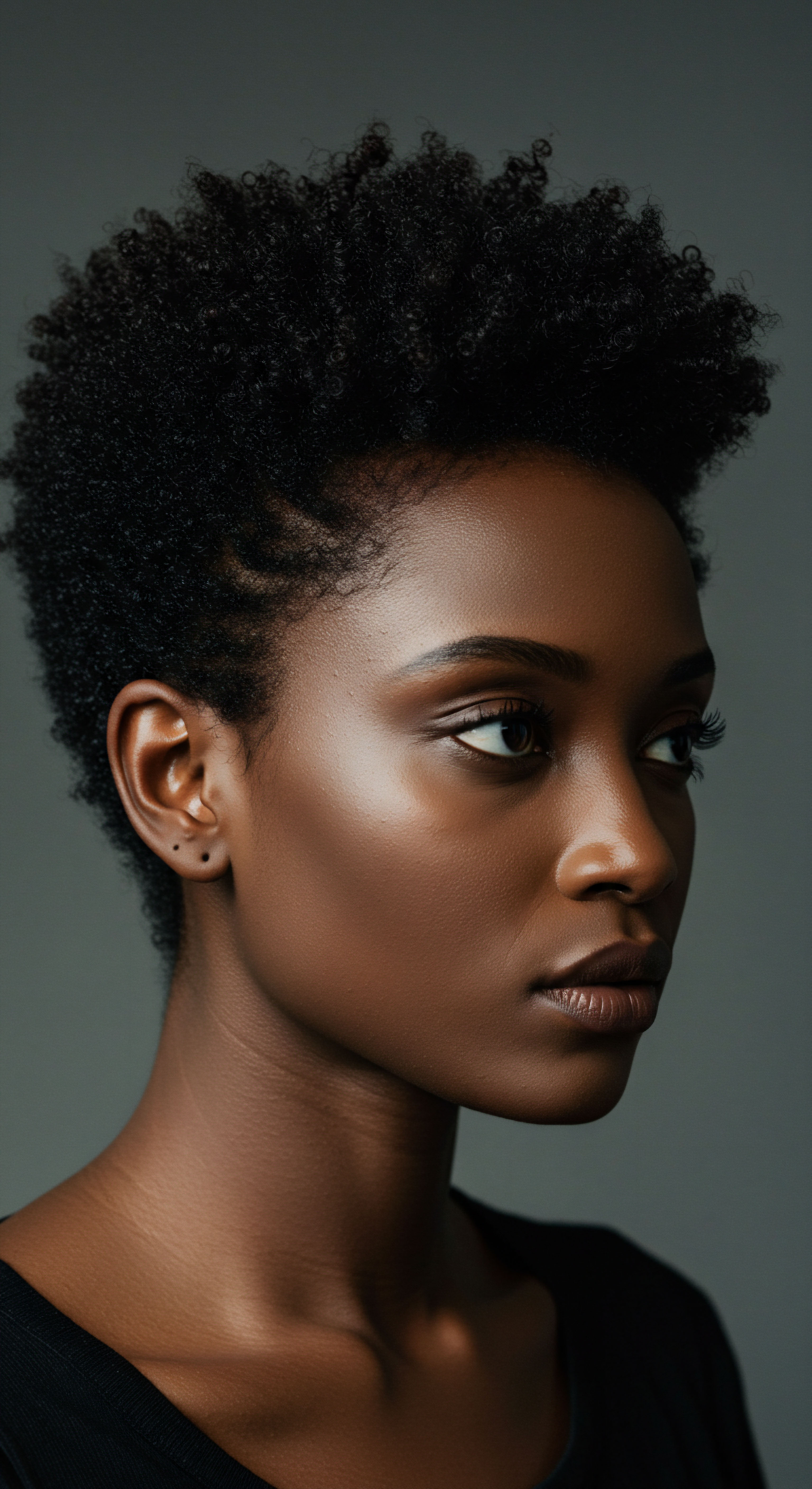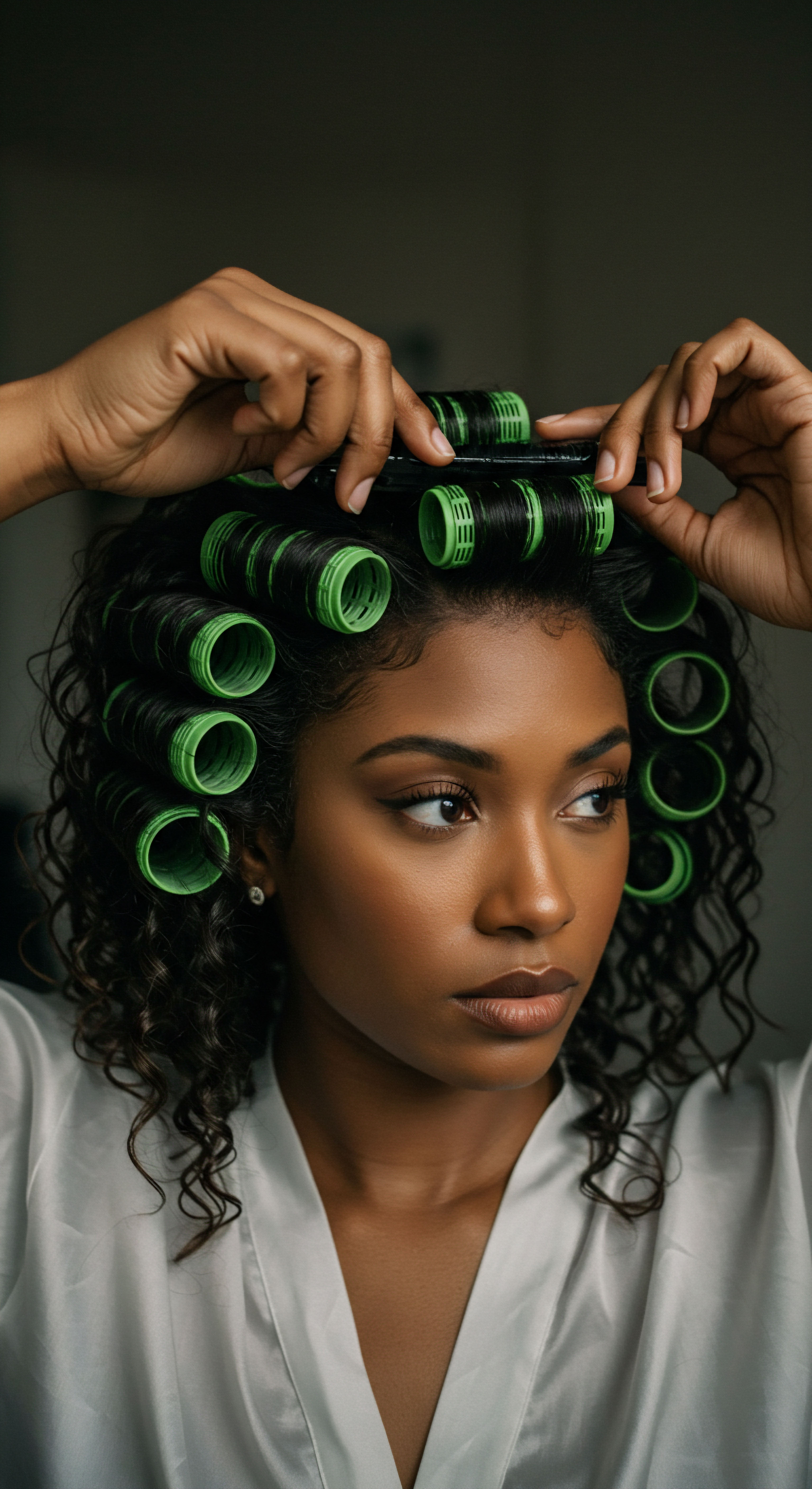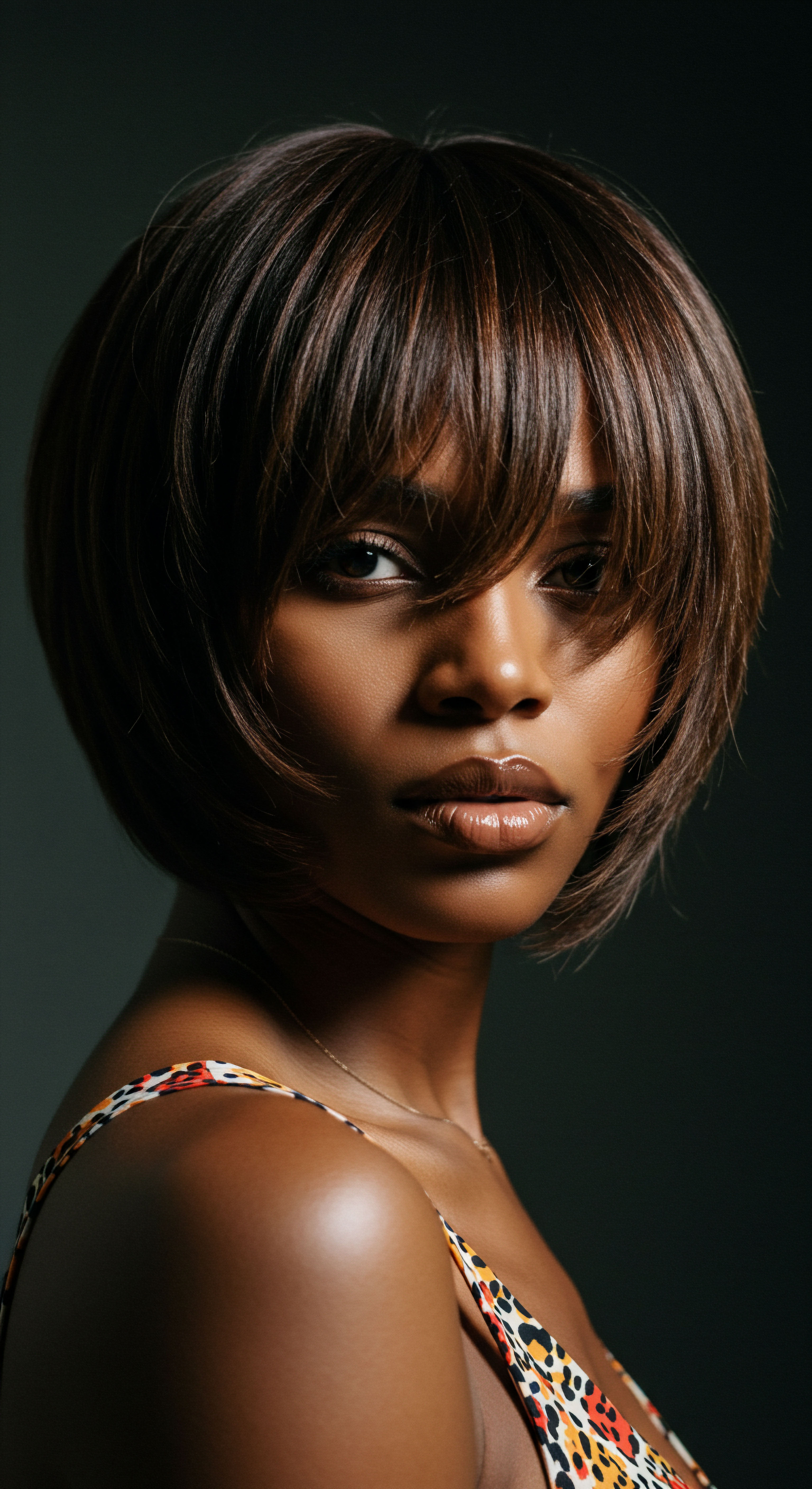
Fundamentals
The delicate dance of rest and renewal shapes more than our spirits; it profoundly influences the very vitality of our hair. The concept of Sleep Influence, within the compassionate gaze of Roothea, speaks to the quiet, yet potent, impact our nightly repose holds over the health, appearance, and resilience of our strands. It is a gentle reminder that hair care extends beyond the waking hours, inviting us to consider the unseen forces at play while we drift into slumber. For those with textured hair, a heritage of unique curl patterns and distinct structural needs, this nocturnal narrative takes on a particular resonance.
Understanding Sleep Influence begins with recognizing that our bodies are continuously working, even when we are still. As we rest, the body engages in a symphony of restorative processes. Cells regenerate, hormones find their delicate balance, and essential nutrients journey to every corner of our being, including the often-overlooked hair follicles.
When sleep is consistent and serene, these fundamental operations proceed unhindered, laying a strong foundation for vibrant hair. Conversely, disruptions to this natural rhythm can manifest in subtle, yet discernible, ways upon our crowns.
Sleep Influence encompasses the profound, restorative power of nightly rest on hair health, particularly for textured strands, affecting everything from cellular repair to moisture retention.

The Quiet Work of Cellular Repair
Each strand of hair, from its deepest root to its shimmering tip, relies on a constant cycle of repair and renewal. During periods of deep sleep, the body prioritizes these cellular activities. Human growth hormone, for instance, finds its optimal release, playing a role in the regeneration of hair follicles.
This means that while we dream, our scalp is actively working to support the emergence of healthier, stronger hair. When this vital process is interrupted, hair may appear lackluster, its natural vibrancy diminished.

Early Lessons in Protection
For generations, particularly within Black and mixed-heritage communities, the wisdom of protecting hair during sleep has been a cherished tradition. Before the widespread scientific explanation, there was an intuitive understanding that friction, the silent aggressor of the night, could compromise delicate curls and coils. Simple coverings, like soft cloths or headwraps, became essential tools for preserving hairstyles and minimizing damage.
This practice, often passed down through families, speaks to an innate recognition of Sleep Influence, long before the term found its way into our lexicon. It highlights how the everyday care of textured hair has always been intertwined with mindful nightly rituals.
- Friction ❉ The rubbing of hair against abrasive surfaces, such as cotton pillowcases, during sleep. This mechanical stress can lift the hair’s delicate outer layer, the cuticle, leading to frizz and breakage.
- Moisture Loss ❉ Many common bedding materials absorb natural oils and moisture from hair, leaving strands dry and more vulnerable to damage. Textured hair, already prone to dryness, is particularly susceptible.
- Tangles ❉ Unprotected hair, especially longer or highly textured hair, can become knotted and matted overnight, making detangling a painful and damaging morning endeavor.

Intermediate
Moving beyond the foundational understanding, the intermediate meaning of Sleep Influence for textured hair delves into the practical manifestations of nightly rest, or its absence, upon our crowns. It is here that we begin to discern the subtle yet significant shifts in hair behavior that emerge from our nocturnal habits. This layer of comprehension invites a more intentional engagement with our evening routines, recognizing them as integral components of a holistic hair wellness journey.
The intricate architecture of textured hair, with its unique bends and spirals, makes it inherently more vulnerable to mechanical stress and moisture depletion. Unlike straight hair, which allows natural oils to travel effortlessly down the shaft, the coiled nature of curly and coily strands can hinder this natural lubrication, leaving ends particularly susceptible to dryness. When we introduce the dynamics of sleep into this equation, the implications for moisture retention and structural integrity become even more pronounced. The surface upon which our hair rests, and the manner in which it is secured, directly shape its condition upon waking.

The Hormonal Cadence and Hair Cycles
Our bodies operate on a circadian rhythm, a natural, internal process that regulates the sleep-wake cycle and repeats roughly every 24 hours. This rhythm orchestrates the release of various hormones, some of which are direct allies to hair health. Melatonin, often celebrated for its role in regulating sleep, also contributes to hair growth.
Cortisol, the stress hormone, finds its levels naturally regulated during periods of adequate rest. When sleep is consistently disrupted, this delicate hormonal balance can waver, potentially shortening the active growth phase of hair follicles and extending the resting phase, which can lead to increased shedding.
Consider the subtle shift in hair texture observed after a period of insufficient sleep ❉ a slight dullness, an unexpected increase in shedding, or a feeling of diminished elasticity. These are not mere coincidences. They represent the hair’s gentle communication, signaling that its foundational support system, deeply rooted in restful nights, may be faltering. Addressing these signals requires a mindful approach to sleep hygiene, viewing it as a vital component of hair care, just as important as the conditioners and oils we apply.
Optimal sleep supports the hair’s natural growth cycles and hormonal balance, acting as a silent partner in maintaining vibrancy and strength.

Strategic Nighttime Protection
Practical steps taken before sleep can significantly mitigate the challenges textured hair faces overnight. These practices are not about mere convenience; they are about preserving the hair’s delicate structure and precious moisture.
The choice of pillowcase material holds surprising weight in this nocturnal protection. Cotton, a widely used fabric, is known for its absorbent qualities. While this makes it comfortable for bedding, it also means it can draw moisture directly from your hair, leaving it parched and prone to friction-induced damage.
| Material Type Cotton |
| Hair Impact Absorbs moisture, increases frizz and breakage |
| Moisture Retention Low |
| Friction Level High |
| Material Type Silk |
| Hair Impact Reduces friction, retains moisture, minimizes frizz |
| Moisture Retention High |
| Friction Level Low |
| Material Type Satin |
| Hair Impact Reduces friction, retains moisture, minimizes frizz |
| Moisture Retention High |
| Friction Level Low |
| Material Type Opting for silk or satin significantly reduces nocturnal hair stress. |
Shifting to a Silk or Satin Pillowcase creates a smooth, frictionless surface that allows hair to glide without snagging or pulling. This simple swap helps retain the hair’s natural oils and applied products, leading to less frizz and better-preserved styles upon waking.
Beyond the pillowcase, protective hairstyles offer an additional layer of defense. Loose braids, twists, or the “pineapple” method (gathering hair gently at the crown) can keep strands contained, preventing tangling and reducing overall friction against bedding. These methods safeguard the curl pattern, ensuring that the morning reveal is one of defined beauty rather than a battle against knots and dryness.
- Loose Braids ❉ Segmenting hair into large, gentle braids minimizes movement and tangling overnight.
- Twists ❉ Similar to braids, twists keep textured strands organized and protected from friction.
- Pineapple Method ❉ Gathering hair loosely at the very top of the head, secured with a soft scrunchie, allows curls to fall freely, preventing crushing.
- Bonnets and Scarves ❉ Satin or silk bonnets and scarves provide an encompassing protective barrier, safeguarding hair from both friction and moisture absorption.

Advanced
The advanced explication of Sleep Influence transcends superficial notions of “beauty sleep,” revealing a complex interplay of physiological mechanisms, material science, and profound cultural practices that collectively shape the destiny of textured hair. This sophisticated understanding requires a deeper dive into the unique biomechanics of Black and mixed-race hair, alongside the often-unacknowledged historical and social dimensions that have shaped its care. The meaning here extends to a comprehensive interpretation of how nocturnal conditions can either fortify or compromise the hair’s structural integrity, its long-term growth trajectory, and its very identity.
For textured hair, characterized by its elliptical cross-section and distinct curl patterns, the hair shaft’s diameter can vary along its length, creating natural points of vulnerability. This structural reality renders it more susceptible to breakage from mechanical forces. When we consider the average person’s nocturnal movement, shifting position up to 40 times each night, the cumulative effect of friction against standard bedding becomes a substantial, yet frequently underestimated, stressor. This constant abrasion, particularly from cotton, can lift and chip the hair’s outermost protective layer, the cuticle, exposing the inner cortex to damage and leading to accelerated moisture loss and frizz.

Nocturnal Traction ❉ A Silent Adversary
A critical, often overlooked aspect of Sleep Influence within textured hair communities is the phenomenon of Nocturnal Traction. This term refers to the sustained or repetitive tension placed on hair follicles during sleep, often a consequence of specific styling practices employed to preserve intricate hairstyles or minimize morning routines. While protective styles like braids, twists, and locs are invaluable during waking hours, the way they are secured or positioned overnight can inadvertently become a source of stress. For instance, tightly pulling hair into a high bun or ponytail, even with soft ties, can exert continuous tension on the hairline and scalp.
Nocturnal traction, stemming from certain sleep-time styling practices, represents a significant yet often unaddressed risk factor for hair loss in textured hair.
A study by Samrao et al. (2021) in Skin Appendage Disorders highlights how patients with afro-textured or curly hair may use various techniques to maintain their hairstyles while sleeping, a behavior not commonly recognized or addressed by healthcare providers. The research suggests that an increased awareness of “nocturnal traction” and inquiring about patients’ nighttime hair practices can help identify individuals at risk for Traction Alopecia (TA). TA, a preventable form of hair loss resulting from chronic tension on hair, is more prevalent in women and those with afro-textured hair due to styling practices.
The paper presents case studies where patients developed patchy alopecia along the temporal scalp, directly corresponding to where rollers were placed at night, or from consistently tight nighttime styles. This insight challenges the simplistic view of sleep-time hair care, urging a more nuanced understanding of how seemingly benign habits can contribute to long-term hair health challenges. The profound implication is that the very strategies intended to protect textured hair can, if not executed with careful consideration for tension, paradoxically become a source of damage.

The Biopsychosocial Nexus of Sleep and Hair
Beyond mechanical stressors, the advanced meaning of Sleep Influence encompasses a biopsychosocial lens. Sleep deprivation elevates stress hormones like cortisol, which can prematurely push hair follicles into the resting (telogen) phase, leading to increased shedding, a condition known as telogen effluvium. This physiological response is universal, yet its impact can be particularly distressing for individuals with textured hair, where perceived hair loss can be more noticeable due to lower average hair density.
The historical context of hair bonnets and wraps, as symbols of resilience and cultural preservation, further deepens the understanding of Sleep Influence. Originating from necessity during enslavement to protect hair from harsh conditions and later evolving into symbols of identity, these coverings represent a collective, generational wisdom about nocturnal hair care. The ritual of wrapping hair before bed, for many Black women, is not merely a practical act but a deeply personal one, connecting them to ancestral practices and affirming a commitment to self-care and cultural continuity. This psychological comfort, knowing one’s hair is protected, can itself contribute to a more restful sleep, creating a virtuous cycle that benefits both mental well-being and hair vitality.
From a corporate and expert perspective, understanding Sleep Influence means recognizing the market’s demand for specialized nocturnal hair care solutions. This involves developing products and accessories that address the unique needs of textured hair, moving beyond generic recommendations. Research into advanced materials that offer superior friction reduction and moisture retention, coupled with ergonomic designs that minimize tension, becomes paramount.
Educational initiatives, informed by nuanced scientific and cultural understanding, are vital to empower consumers to make informed choices that safeguard their hair’s long-term health. The success of such endeavors hinges upon a deep appreciation for the historical significance of hair care practices within specific communities and a commitment to evidence-based innovation that respects and supports diverse hair journeys.
The profound significance of Sleep Influence also extends to the subtle yet impactful processes occurring at the cellular level. During restful periods, the body actively synthesizes proteins, including keratin, the primary protein component of hair. This protein synthesis is critical for repairing existing hair and building new, stronger strands. When sleep is consistently insufficient, this vital construction work is compromised, potentially leading to weaker, more brittle hair that is susceptible to damage.
| Process Hormone Regulation |
| Hair Health Connection Melatonin promotes growth, cortisol balance reduces shedding. |
| Impact of Sleep Disruption Imbalanced hormones can shorten growth phase, increase hair loss. |
| Process Cell Regeneration |
| Hair Health Connection Hair follicles undergo repair and renewal. |
| Impact of Sleep Disruption Impaired cellular repair leads to weaker, less vibrant hair. |
| Process Protein Synthesis |
| Hair Health Connection Keratin production for hair strength and repair. |
| Impact of Sleep Disruption Reduced protein building can cause brittle, damaged strands. |
| Blood Circulation |
| Delivers oxygen and nutrients to follicles. |
| Diminished flow can starve follicles, hindering growth. |
| Process Adequate sleep is a prerequisite for robust hair at the microscopic level. |
The comprehensive delineation of Sleep Influence, therefore, encompasses not only the tangible aspects of friction and moisture but also the invisible, yet potent, biological and cultural forces that converge each night. It is a testament to the profound connection between our inner well-being and the external vitality of our textured hair, urging a holistic approach that honors both science and heritage.

Reflection
As we draw our exploration of Sleep Influence to a close, a gentle truth settles upon us ❉ the profound connection between our nightly rest and the living crown we carry. For textured hair, this connection is not a mere suggestion, but a deep, resonant chord, echoing through generations of care and resilience. Each intentional act, from choosing a silken pillowcase to crafting a protective style, becomes a whisper of affirmation, honoring the unique needs of our strands.
The quiet hours of slumber are not simply a pause in our day, but a sacred space where rejuvenation unfolds, weaving strength and vibrancy into every curl and coil. May we continue to listen to our hair’s wisdom, allowing the gentle rhythm of sleep to nurture its inherent beauty, night after peaceful night.

References
- Samrao, A. et al. (2021). Nocturnal Traction ❉ Techniques Used for Hair Style Maintenance while Sleeping May Be a Risk Factor for Traction Alopecia. Skin Appendage Disorders, 7(3), 220-223.
- Schwartz, E. K. & Knowles, M. S. (1963). Frictional Effects in Human Hair. Journal of the Society of Cosmetic Chemists, 14(7), 405-415.
- Bhushan, B. et al. (2014). Friction Dynamics of Straight, Curly, and Wavy Hair. Journal of Cosmetic Science, 65(3), 137-147.
- Johnson, D. A. (2018). Sleep Health Disparities in Black Women. Journal of Racial and Ethnic Health Disparities, 5(5), 1017-1025.
- Goren, A. et al. (2015). Lifestyle Factors and Hair Loss. Journal of Clinical and Aesthetic Dermatology, 8(12), 35-41.
- McMichael, A. J. et al. (2011). Hair and Scalp Disorders in Ethnic Populations. Dermatologic Clinics, 29(1), 11-27.
- Gavazzoni Dias, M. F. R. (2015). Hair Cosmetics ❉ An Overview. International Journal of Trichology, 7(1), 2-15.
- Trueb, R. M. (2003). The Impact of Stress and Sleep Deprivation on Hair Health. Journal of the American Academy of Dermatology, 49(1), 123-128.
- Draelos, Z. D. (2010). Hair Care ❉ An Illustrated Dermatologic Handbook. Informa Healthcare.
- Randhawa, M. et al. (2006). The Effect of Sleep on Skin and Hair. Journal of the American Academy of Dermatology, 54(3), AB13.
- Rushton, D. H. (2002). Nutritional Factors and Hair Loss. Clinical and Experimental Dermatology, 27(5), 396-404.
- Sperling, L. C. (2012). Hair Diseases. Elsevier Health Sciences.
- Dawber, R. P. R. & Van Neste, D. (2001). Hair and Scalp Diseases ❉ Medical, Surgical, and Aesthetic Aspects. CRC Press.
- Messenger, A. G. & de Berker, D. A. R. (2011). The Biology of Hair Follicles. Journal of Investigative Dermatology Symposium Proceedings, 15(1), 1-14.
- Headington, J. T. (1984). Telogen Effluvium ❉ A Clinical Study of 100 Patients with Acute Hair Loss. Archives of Dermatology, 120(1), 120-123.